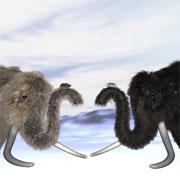 Mammoth hair samples recovered from permafrost have helped artists to pick a colour for their coats.© Science
Mammoth hair samples recovered from permafrost have helped artists to pick a colour for their coats.© ScienceYou might call them the Marilyn Monroes of the mammoth world. An analysis of 43,000-year-old DNA from these prehistoric creatures suggests that some of them were blondes.
Textbook pictures of woolly mammoths (Mammuthus primigenius) typically depict the shaggy beasts sporting a coat of brown hair. But they probably came in a range that also featured lighter browns and auburns, the study suggests.
Some naturalists already suspected that a few mammoths might have been blonde. Hairs found buried in the frozen tundra, where the creatures lived until their extinction some 3,500 years ago, come in range of different shades. "But we didn't know if it was genetic or just a result of being in the ground for tens of thousands of years," says Michael Hofreiter of the Max Planck Institute for Evolutionary Anthropology in Leipzig, Germany, who led the research.
Rather than studying the hair itself, he and his colleagues turned to ancient mammoth bone to solve the conundrum. They took samples from a 43,000-year-old bone found in Siberia, and extracted the portion of DNA containing a key pigmentation gene, Mc1r.
Most mammalian genes are present in two copies - one from each parent. Hofreiter and his team found that this mammoth's two copies of Mc1r differed slightly. And when they investigated the proteins produced by the two versions, they discovered that one functions far better than the other in producing brown pigment. They publish the results in this week's Science1.
Blonde minority
The more effective version of the gene is responsible for richly pigmented brown hair, the researchers suggest. The weaker version probably produces lighter brown, blonde or reddish shades.
The researchers knew which gene to look for because all mammals possess versions of the Mc1r gene, Hofreiter explains. A single copy of the strongly acting version is enough to create brown hair, which is why natural blondes are in the minority in humans; ordinarily it takes two copies of the weaker version to give lighter shades. Mutations in the gene are associated with lack of pigment; rare blond versions versions of the American black bear can attribute their distinctive looks to defects in the same gene.
With one copy of each version, the 43,000-year-old mammoth in this study was probably a brunette. Samples from three more mammoths also failed to find one that would have been blonde. But the fact that the 'blonde gene' was present in the population gives credence to the theory that light-coloured hairs found in the ice genuinely reflect their owners' coat colours.
Spot the mammoth
ADVERTISEMENT
It is impossible to say, without unearthing a fully preserved mammoth, whether they would have been uniform in colour or whether patterns of different hair colours mdash; from spots to stripes mdash; were possible. It is also unclear whether blonde or brown mammoths would have enjoyed a natural advantage, although it seems unlikely given that they had little need for camouflage.
More important, Hofreiter suggests, was the thickness of the mammoth's hairy coat in protecting against the icy tundra weather. "It would maybe have been icy and snowy, and certainly very cold," he says.
Visit our getlighter.html">newsblog to read and post comments about this story.
